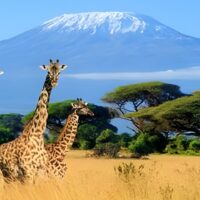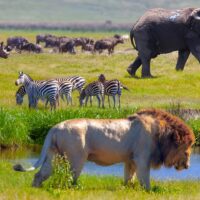Last Updated on February 22, 2025 by Mammals Life
Goats primarily inhabit mountainous regions, grasslands, and deserts. They adapt to diverse environments worldwide.
Goats are versatile creatures found in various natural habitats. They thrive in mountainous areas, where their agility helps them navigate rocky terrain. Grasslands provide ample grazing opportunities, making them ideal for goats. Deserts also host goats, showcasing their ability to endure harsh conditions.
These adaptable animals have evolved to survive in different climates and landscapes. Understanding where goats roam offers insight into their resilient nature and ecological roles. This knowledge is crucial for conservation efforts and sustainable farming practices. By exploring their habitats, we appreciate the unique characteristics that make goats such remarkable animals.
Mountainous Regions
Goats thrive in mountainous regions. They navigate rocky terrains with ease. These areas provide them with food, shelter, and safety.
High Altitude Adaptations
Goats have unique adaptations for high altitudes. Their lungs are large, helping them breathe thin air. They also have strong hooves to grip rocks.
- Large lungs: Enable better oxygen intake.
- Strong hooves: Provide stability on rocky surfaces.
- Thick fur: Keeps them warm in cold climates.
Predators And Threats
Mountain goats face many predators. These include wolves, bears, and large birds. They also face threats from harsh weather and food scarcity.
| Predator | Threat Level |
|---|---|
| Wolves | High |
| Bears | Medium |
| Large Birds | Low |
Grasslands And Meadows
Grasslands and meadows are home to many goats. These areas provide food and space for them. Goats love these open spaces.
Diet And Grazing Patterns
Goats eat grass, herbs, and shrubs. They enjoy grazing on fresh, green plants. They have a special way of eating. They nibble on the tops of plants. This helps the plants grow back quickly.
Goats are not picky eaters. They eat almost any plant they find. This includes weeds and thorny bushes. They help keep the grasslands clean and healthy.
Seasonal Migrations
Goats move with the seasons. In summer, they stay in high meadows. These areas have cool weather and lots of fresh food. In winter, they move to lower grasslands. These areas are warmer and have less snow.
This movement helps them find the best food and weather. It also helps the plants grow back. Goats play a key role in the ecosystem.
Desert Environments
Deserts are harsh and dry places. Yet, goats thrive here. They have special skills to survive. Let’s explore how goats live in desert environments.
Water Conservation Strategies
Water is scarce in deserts. Goats need clever ways to save water.
- Goats have thick fur. It reduces water loss.
- They drink a lot at once. It helps store water.
- Goats find water in plants. They eat cactus and other succulents.
Unique Foraging Techniques
Food is hard to find in deserts. Goats use unique ways to forage.
- Goats eat a wide range of plants. This includes thorny bushes.
- They can stand on their hind legs. This helps reach high branches.
- Goats move constantly. They search for food in large areas.
| They stand on their hind legs to eat high branches. | Description |
|---|---|
| Broad Diet | Goats eat many types of desert plants. |
| Standing to Reach | They stand on hind legs to eat high branches. |
| Constant Movement | Goats travel long distances to find food. |
Forest Habitats
Goats, known for their adaptability, thrive in various habitats. One such habitat is the forest. Forests offer a unique environment for goats. The dense vegetation provides food and shelter. This section delves into the specifics of goats in forest habitats.
Shelter And Safety
Forests offer natural shelters for goats. Trees and bushes provide cover from predators and harsh weather. Goats often rest under thick canopies. This natural shelter keeps them safe from rain and sun. Fallen logs and rocks also serve as hiding spots. These elements make forests ideal for goat safety.
Interaction With Other Wildlife
In forests, goats interact with various wildlife. They share their habitat with deer, birds, and insects. These interactions are usually peaceful. Goats may compete with deer for food. Yet, they often graze in different areas. Birds sometimes follow goats, eating insects stirred up by their movement. This creates a balanced ecosystem.
Goats also play a role in the forest food chain. Predators like wolves and big cats may hunt them. This keeps the predator population in check. Thus, goats contribute to the forest’s biodiversity.
| Aspect | Details |
|---|---|
| Shelter | Trees, bushes, fallen logs, and rocks |
| Safety | Protection from predators and harsh weather |
| Wildlife Interaction | Deer, birds, insects, and predators |
- Natural shelters: Trees and bushes
- Hiding spots: Fallen logs and rocks
- Wildlife neighbors: Deer, birds, insects
- Goats find food in the forest.
- They use trees for shade and shelter.
- Birds follow goats for easy meals.
- Predators hunt goats, balancing the ecosystem.
Savannas And Woodlands
Goats love to live in savannas and woodlands. These areas have the perfect mix of grass and trees. Goats find plenty to eat here. Let’s explore how goats thrive in these places.
Climate Resilience
Goats are very resilient. They can handle hot and dry climates. Savannas often have long dry seasons. Goats can survive with little water.
In woodlands, goats find shade under trees. This helps them cool off. Goats also eat leaves and bark when grass is scarce. Their diet is very flexible.
Social Structures
Goats are social animals. They live in herds. Herds protect from predators. Each herd has a leader, often a strong male.
Herds in savannas and woodlands are often large. This makes them feel safe. Goats communicate through bleats and body language. They stay close to each other.
| Environment | Key Features |
|---|---|
| Savannas | Hot, dry, grassy |
| Woodlands | Shady, leafy, varied diet |
Human Impact
Human activities have greatly affected the natural habitats of goats. These impacts come in various forms and can lead to significant changes in goat populations.
Habitat Encroachment
Habitat encroachment is one of the biggest threats to goats. As humans build more homes and roads, goats lose their natural habitats. This forces them to move to less suitable areas.
Farmers often clear land for agriculture. This reduces the space available for wild goats. Goats then have to compete for food and shelter.
| Human Activity | Impact on Goats |
|---|---|
| Urbanization | Loss of natural habitats |
| Agriculture | Reduction in food sources |
| Road Building | Habitat fragmentation |
Conservation Efforts
Conservation efforts aim to protect goat habitats. These efforts involve both government and private organizations. They work to create protected areas where goats can live safely.
One approach is to set up wildlife reserves. These areas are off-limits to human development. This allows goats to thrive without interference.
- Protected Areas
- Wildlife Reserves
- Reforestation Projects
Reforestation projects help restore habitats. Planting trees and other plants provides food and shelter for goats. This also helps improve the overall ecosystem.
Frequently Asked Questions
Where Is Goat In Its Natural Habitat?
Goats naturally inhabit mountainous regions, grasslands, and deserts. They adapt well to rugged terrains and varied climates.
Will Goats Roam?
Yes, goats will roam. They are naturally curious and will explore their surroundings if not properly contained.
How Are Goats Suited To Their Habitat?
Goats thrive in diverse habitats due to their adaptability. They efficiently forage on varied vegetation. Their strong, agile bodies navigate rough terrains easily.
What Is The Natural Environment Of A Goat?
Goats thrive in mountainous regions, grasslands, and deserts. They adapt well to rocky terrains and sparse vegetation.
Where Do Goats Naturally Live?
Goats naturally live in mountainous regions, grasslands, and semi-arid areas worldwide.
What Do Goats Eat In The Wild?
In the wild, goats eat grasses, shrubs, leaves, and sometimes tree bark.
Conclusion
Goats thrive in diverse habitats, from rocky mountains to grassy plains. Their adaptability ensures their survival. Understanding their natural environments helps in conservation efforts. By protecting these habitats, we support goat populations and biodiversity. Keep exploring and learning about these fascinating creatures and their unique ecosystems.








